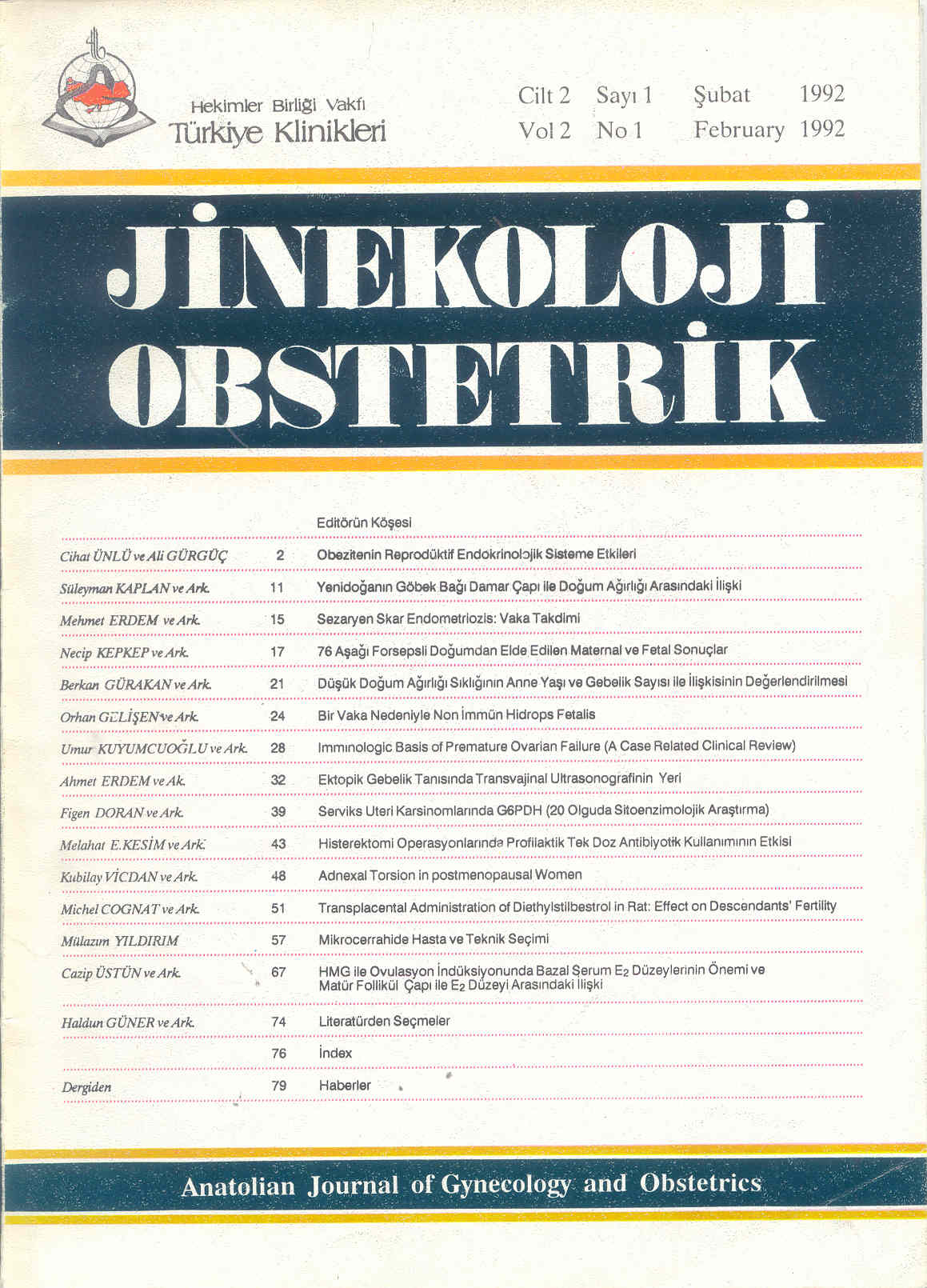Open Access
Peer Reviewed
ARTICLES
3088 Viewed877 Downloaded
Transplacental Administration of Diethylstilbestrol in Rat: Effect on Descendants' Fertility
Ratlara Transplasental Dietilstilbestrol Verilmesinin Yeni Jenerasyonun Fertilitesine Etkisi
Turkiye Klinikleri J Gynecol Obst. 1992;2(1):51-6
Article Language: TR
Copyright Ⓒ 2025 by Türkiye Klinikleri. This is an open access article under the CC BY-NC-ND license (http://creativecommons.org/licenses/by-nc-nd/4.0/)
ÖZET
Bu çalışmada, DES'un üreme sistemi üzerine olan etkisi araştırılmıştır. Bu amaçla, gebe SPrague Dawley; OFA farelere, DES subkutan olarak günde 10, 20, 50 ve 100 mikrogram/kg olmak üzere, gebeliğin 10-18 günleri arasında (long time) ve gebeliğin 13-18. günler arasında (short time) aynı dozlarda uygulanmıştır. Sadece düşük doz verilen grup (10 µg/kg/günde; kısa ya da uzun süre ile 20 µg/kg/günde kısa süre olanlar) canlı sağlam yavrular doğurmuşlardır. Erkek ve dişi yavruların fertiliteleri postnatal üreme teknikleri ile tespit edilmiş ve dişilerde %70-80 nisbetinde sterilite, erkeklerde ise %11-18 oranında patolojik fekondite görülmüştür. Bu patolojik fekonditeli farelerde fertilitesi normal görülen fareler doğurmuştur.
Bu çalışmada, DES'un üreme sistemi üzerine olan etkisi araştırılmıştır. Bu amaçla, gebe SPrague Dawley; OFA farelere, DES subkutan olarak günde 10, 20, 50 ve 100 mikrogram/kg olmak üzere, gebeliğin 10-18 günleri arasında (long time) ve gebeliğin 13-18. günler arasında (short time) aynı dozlarda uygulanmıştır. Sadece düşük doz verilen grup (10 µg/kg/günde; kısa ya da uzun süre ile 20 µg/kg/günde kısa süre olanlar) canlı sağlam yavrular doğurmuşlardır. Erkek ve dişi yavruların fertiliteleri postnatal üreme teknikleri ile tespit edilmiş ve dişilerde %70-80 nisbetinde sterilite, erkeklerde ise %11-18 oranında patolojik fekondite görülmüştür. Bu patolojik fekonditeli farelerde fertilitesi normal görülen fareler doğurmuştur.
ANAHTAR KELİMELER: DES, Rat, infertilite
ABSTRACT
In order to determine the effects of transplacental exposure to diethylstilbestrol (DES) on the descendants' fertility, pregnant Sprague Dawley OFA rats were treated with DES (10, 20, 50 and 100 µg/kg/d, subcutaneous) from day 10 to 18 of gestation (long time) or day 13 to 18 of gestation (short time). Only the group given the lowest doses (10 µg/kg/d, short and long times, and 20 µg/kg/d, short time) gave birth to alive descendants. The fertility of the male and female descendants was determined postnatally by a breeding technique and appeared to be strongly decreased among females of all groups (70 to 100%) of sterility) and moderately among males (11 to 18% of pathological fecundity). These rats with pathological fecundity gave birth to descendants whose fertility appeared to be normal.
In order to determine the effects of transplacental exposure to diethylstilbestrol (DES) on the descendants' fertility, pregnant Sprague Dawley OFA rats were treated with DES (10, 20, 50 and 100 µg/kg/d, subcutaneous) from day 10 to 18 of gestation (long time) or day 13 to 18 of gestation (short time). Only the group given the lowest doses (10 µg/kg/d, short and long times, and 20 µg/kg/d, short time) gave birth to alive descendants. The fertility of the male and female descendants was determined postnatally by a breeding technique and appeared to be strongly decreased among females of all groups (70 to 100%) of sterility) and moderately among males (11 to 18% of pathological fecundity). These rats with pathological fecundity gave birth to descendants whose fertility appeared to be normal.
MENU
POPULAR ARTICLES
MOST DOWNLOADED ARTICLES





This journal is licensed under a Creative Commons Attribution-NonCommercial-NoDerivatives 4.0 International License.










